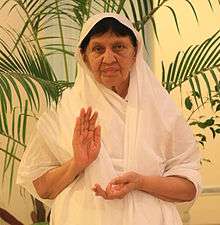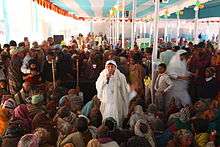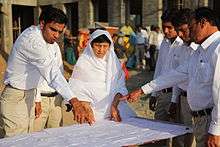Acharya Chandana
Acharya Chandana, also known as Tai Maharaj, and Chandanaji, became the first Jain woman to receive the title of Acharya in 1987.[1] She belongs to the Amarmuni Sampradaya which, as of 2013, is the only monastic lineage to promote a nun to the rank of Acharya.[2] This is controversial within the Jain community.[3] She is known for introducing the concept of seva (service to humanity) among the Jain .
Acharya Chandana | |
|---|---|
 | |
| Official name | Acharya Shri Chandanaji |
| Personal | |
| Born | Shakuntala January 26, 1937 Chaskaman, Maharashtra |
| Religion | Jainism |
| Parents | Sh. Manikchand & Smt. Prem Kuwar |
| Alma mater | Degree in Darshanacharya from Bhartiya Vidya Bhavan, Mumbai, Sahitya Ratna from Prayag, Masters from the Pathardi Dharmik Pariksha Board, 'Shastri’ in the subjects of Navya-Nyaya and Vyakaran from Banaras Hindu University. |
| Religious career | |
| Initiation | Sadhvi Chandana by Pujya Gurudev Upadhyay Amar Muniji Maharaj |
| Website | www |
| Part of a series on |
| Jainism |
|---|
 |
|
Jain prayers |
|
Ethics |
|
Major sects |
|
Texts |
|
Festivals
|
|
|


In 1972, she began her humanitarian work in a poverty-stricken area in the state of Bihar, India. She founded Veerayatan - a non-profit, non-governmental service organization which as of 2013 has centers in more than ten countries.[4] A biopic Never Before has also been made to commemorate her life.
Early life
Chandana was born into a Kataria family in the Chaskaman village of Maharashtra on 26 January 1937. Her mother, Prem Kuwar, and father, Manikchand named her Shakuntala. She took formal education till class 3rd in Chaskaman.
Her maternal grandfather convinced her to take initiation under the Jain Sadhvi Sumati Kuwar so that she could study and help others.
At the age of fourteen she renounced the world, took Jain diksha and became Sadhvi Chandana. She took a twelve-year vow of silence to study Jain scriptures, the meaning and purpose of life and different religions. She obtained the degree of Darshanacharya from Bhartiya Vidya Bhavan, Mumbai, Sahitya Ratna from Parayg, a master's degree from the Pathardi Dharmik Pariksha Board and she gained the title of Shastri in the subjects of Navya-Nyaya and Vyakaran from Banaras Hindu University.
Chandana met with opposition from other followers of Jainism when she advocated the extension of the philosophy of Mahavira from its traditional use in rituals and in finding moksha to application in everyday life. She contended that relieving suffering in others was a form of spirituality.
In 1998, Chandana traveled to Cleveland, Ohio, where she offered the opening prayer at the National Federation of Asian Indians of North America convention and was honoured for her contributions to peace.[2]
Founding of Veerayatan
Veerayatan, founded by Chandana in 1974 in Bihar,[3] is an international charitable organization which seeks to create social transformation among impoverished people through spiritual development, quality education and service to others without discriminating against caste, creed, race or gender.[5]
Veerayatan operates hospitals, schools, colleges, and vocational training programs for the underprivileged throughout India.[4] It initiated emergency relief camps and rehabilitation programs in the aftermath of the 2001 earthquake in Gujarat,[6] the tsunami in 2004, during the Surat floods in 2006 and the Kosi river floods in 2008.
Museums
Chandana is also an artist. She has set up a museum named Shri Brahmi-Kalamandiram in Bihar which houses her artifacts and other creations. She also traveled abroad to support the creation of a museum at the Leicester Jain center in the United Kingdom.
Future Programs
Chandana has begun work on a project named Divine World in the pilgrimage city of Palitana, expounding the message of Tirthankara.
Recognition and awards
- Shri Devi Ahilya National Award, 2002 for her humanitarian services and animal welfare activities
- Sant Balji Award
- JAINA Presidential Award, 2007
References
- Christopher Patrick Miller; Jeffery D. Long; Michael Reading (15 December 2019). Beacons of Dharma: Spiritual Exemplars for the Modern Age. Rowman & Littlefield. pp. 7, 10-. ISBN 978-1-4985-6485-4.
- Tarunjit Singh Butalia; Dianne P. Small (2004). Religion in Ohio: Profiles of Faith Communities. Ohio University Press. pp. 369–. ISBN 978-0-8214-1551-1.
- Kristi L. Wiley (2009). The A to Z of Jainism. Scarecrow Press. p. 32. ISBN 978-0-8108-6821-2. Retrieved 4 July 2013.
- Kurt Titze; Klaus Bruhn (1998). Jainism: A Pictorial Guide to the Religion of Non-violence. Motilal Banarsidass. pp. 270–. ISBN 978-81-208-1534-6.
- Chapple, Christopher Key (2006). Jainism and Ecology: Non Violence in the Web of Life. Motilal Banarsidass. p. 166. ISBN 978-81-208-2045-6.
- "Makeshift Schools Ease Trauma of India Quake". The New York Times. April 8, 2001.